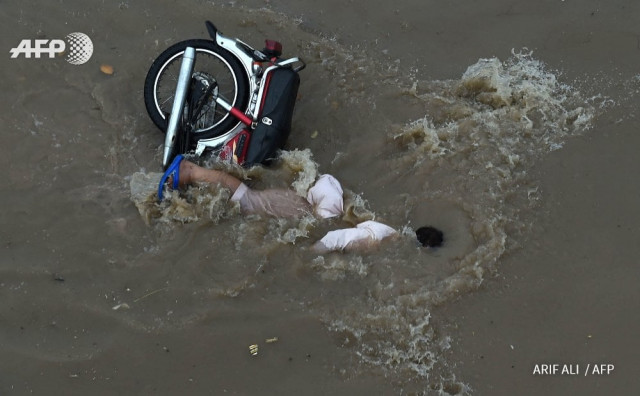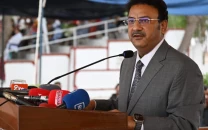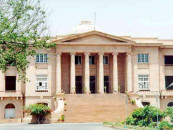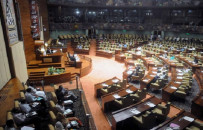Erratic weather events more likely
Karachi hit by frequent tropical cyclones, heavy rains, heatwaves and droughts in last 16 years

Picture shows a biker has fallen down after heavy rainfall was witnessed by Lahore on August 25, 2016. PHOTO AFP
Dr Ghulam Rasul, the director-general of Pakistan Meteorological Department, says that during the first 16 years of the 21st century, Karachi experienced an increased frequency of extreme events such as tropical cyclones, heavy rains, heatwaves and droughts.
Biodiversity in danger: Rapid global warming threatens ecosystems
What’s the connection?
Scientists have long hesitated linking climate change with rise in extreme weather events due to lack of long-duration data but more and more experts are now coming forward to stress the connection. As meteorologists put it, climate is a combination of ‘base state’ - the level of temperature, energy and moisture among other things in the atmosphere - and ‘variation’ - the regular ups and downs. Warming of the atmosphere is changing the ‘base state’ of the climate by putting, for example, more energy and moisture in the system and speeding up the processes they produce.

More heat in the earth atmosphere means more hot air meets cooler air and forms stronger cyclones and inundates coastal areas. It increases evaporation and results in heavier downpour. It reduces precipitation and, combined with evapotranspiration, causes droughts. It also causes glaciers to melt and oceans to expand and leads to flooding.
Damages
Given the poor state of affairs in the country’s biggest city, extreme weather events bring life to a standstill and in worst cases, cause damage to life and property. Disaster management specialist at United Nations Development Programme (UNDP), Muhi Usamah, says acute poverty and limited access to basic necessities such as water and housing in Karachi make extreme weather events more complex to handle.
Rise in average temperature: Longer summers, warmer nights and extreme weather event
Detailing how a community suffers due to increase in extreme weather events, environment expert at the International Union for Conservation of Nature, Nadeem Mirbahar, says disasters such as floods, heatwaves and cyclones damage vital physical infrastructure such as roads, hospitals and airports as well as the communications system. “Livelihoods are also destroyed as agriculture lands, livestock and businesses are lost,” he explains. “This in turn increases people’s vulnerability.”
Extreme weather events, Mirbahar adds, also have a negative impact on community health as diseases spread, nutrition intake lessens and anxiety, fear and stress increase.
Mitigation
To prevent or minimise damages from natural disasters, UNDP’s Usamah says it is important to undertake a complete assessment of possible events, establish relevant laws and regulations and work with communities at risk.
Stressing to have a practical approach, Usamah says authorities should work together on a contingency plan for existing high-risk areas as well as prevent the growth of future threats by not developing new high-risk zones.
Listing specific measures needed to ensure Karachi is well prepared in the face of extreme weather events, Met chief Rasul says Karachi should not be allowed to expand anymore in size as it is already a massive metropolitan. “Its natural water ways known as nadian must be restored and encroachment of water channels should be strictly stopped,” he says. “Existing infrastructure including drainage, sewerage, roads and bridges must be revisited to accommodate future weather extremes and all of the new structures should be climate-resilient.”
Additionally, Rasul says that to absorb heat and pollution, the city needs to grow more trees, protect parks and regulate industrial emissions and effluents.
In recent times
Dr Ghulam Rasul, the director-general of Pakistan Meteorological Department, gives examples of some extreme weather events that the metropolis has experienced in recent history.
Global warming altering sea as we know it
Tropical cyclones
According to Rasul, only seven tropical cyclones crossed the Arabian Sea in the 20th century at a distance of more than 200 kilometres (km), with the closest one coming in 1999 at the distance of 137km. However, in the 21st century, he shares, there was hardly any year without tropical cyclones after 2005. “In 2007, two tropical cyclones, Gonu (super cyclone of Category 5 - first ever formed in the Arabian Sea) and Yemyin, made a land fall on the Pakistan coast near Pasni and inflicted heavy loss of lives and property due to gale winds and a very heavy downpour,” he says.
Very recently, Rasul says Phet and Nilofer threatened the lives and infrastructure of Karachiites, producing stormy winds and lashing the coastal belt with heavy precipitation banning the sea for citizens and fishermen for a week.
Heavy rains
Rasul says heavy rains were not a common phenomenon in Karachi but now gentle rains hardly come to the city. “During the last 15 years, five extreme precipitation events have taken place yielding more than 100 millimetres (mm) rain in a day,” he says.
Heatwaves
With sea breeze a God-gifted regulator of temperature in the summers, Rasul says it brings day temperatures 6-8°C below in Karachi as compared to temperatures in other parts of Sindh. “Due to increased frequency of tropical cyclones in the Arabian Sea, sea breeze stops and heatwave conditions occur in the city. The severity of heatwaves further intensifies due to local effects of heat island, lack of trees, increased concentration of smoke and other pollutants,” he explains.
Rasul says the longest and strongest heatwave so far was experienced in June, 2015, which took hundreds of lives. “In the future, as Karachi’s temperature is expected to increase by 2°C from the present level till 2050, the heatwaves are likely to be more frequent and longer,” he warns.
Drought
Water supply, Rasul says, is already a big problem due to the size of the city as well as managerial reasons.
“In [the] future, Hub Dam supply will become highly uncertain due to high probability of drought in Sindh and total dependence of water supply will be from the Indus. Rainfall in Karachi and in areas around it is predicted to be highly erratic over temporal and spatial scales, which will disturb the water supply to Karachi,” says Rasul. This is the concluding part of a four-part series on the effects of climate change in Karachi.
Published in The Express Tribune, September 19th, 2016.



















COMMENTS
Comments are moderated and generally will be posted if they are on-topic and not abusive.
For more information, please see our Comments FAQ